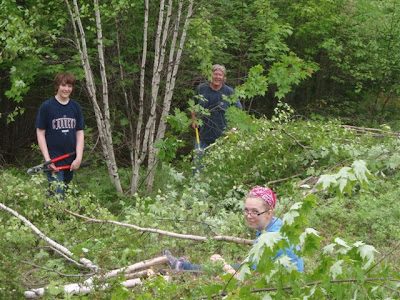Land Steward Bart Hunter, SPNHF Forester Wendy Weisiger, TNC Stewardship Ecologist Joanne Glode and I recently spent the day at the Heald Tract in Wilton with NH DRED Forest Health Specialist Jen Weimer to look at an infestation of Hemlock Woolly Adelgid (HWA) that has recently been identified there. HWA looks like small cottony white balls on the underside of hemlock branches. It's not a fungus, as you might suspect from the look of it, but is actually an insect pest. The woolly balls are the egg sacs of a very small, fluid-feeding insect that sucks sap out of hemlock needles, causing them (and eventually the whole tree) to die. Birds, mammals, and even wind spread the small insects from hemlock to hemlock, increasing the extent of an infestation.

HWA on the underside of hemlock needles
An invasive exotic pest, HWA was first discovered in Pennsylvania in the 1960s. Since then it has been slowly spreading northward , just reaching the NH border in the past few years. In New Hampshire it has been discovered primarily in towns along the southern border with Massachusetts, and forest health experts expect it will continue to spread. It may be that New Hampshire's cold winters will keep the insect in check to some degree, preventing or delaying spread to more northerly areas of the state, but that is only speculation at this point. What we do know is that it's here, and complete eradication of the pest is not a realistic option now. Individual trees (generally specimen street or yard trees) can be "cured" via injection with a systemic pesticide, but it's not feasible to treat all the hemlocks in a forest this way. NH Division Forests & Lands is also experimenting with releasing two types of bio-control beetles which feed on the adelgid-- this is also not expected to eradicate the pest but simply keep it in check enough to hopefully prevent the trees from dying.

Jen Weimer, NH Forest Health Specialist, looks for HWA at Heald Tract
At the Forest Society's Heald Tract in Wilton, the known infestation is limited to one location at the moment. Prognosis is not great, however, as more extensive infestations have also been found on abutting and nearby properties, including the Nature Conservancy's Sheldrick Forest which shares a trail system with Heald. At this time, the Heald infestation is not large enough to justify releasing bio-control beetles, so our plan is to simply monitor the situation. Stewards and volunteers at Heald will be checking for the fluffy white balls on the underside of hemlock branches as they conduct their other land stewardship activities and hopefully, in the meantime, a more effective method of treating the adelgid will be developed.
HWA is fairly easy to identify once you know what you're looking for. If you have hemlocks on the property you monitor for SPNHF, try flipping over the accessible branches to see if you can find any small white cottony masses. Be aware that spittlebugs (a native and non-destructive insect) can create white blobs under hemlock needles too, but these are constructed of hundreds of miniscule bubbles, not "wool". Knowing the extent of the HWA infestation in New Hampshire is critical to Forest & Lands ability to make management decisions and track the spread of this invasive pest. If you do find something that looks like HWA, take a photograph if you have a camera, and be sure to note your location well so that you'll be able to describe it to me or the state Forest Health Specialists. Land Stewards for the Forest Society are in a unique position to assist in monitoring this and other forest pest invasions as we are outside on forested properties across the entire state. Please take a look the next time you pass a hemlock on the trail!

Don't be fooled! This is spittle bug (bubbles), not HWA (wooly)









 The view was nice even before the clearing project (photo: C.Deegan)
The view was nice even before the clearing project (photo: C.Deegan) Terry at the trail dedication last fall (photo: P.Doscher)
Terry at the trail dedication last fall (photo: P.Doscher)